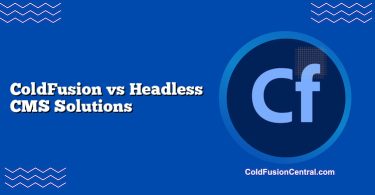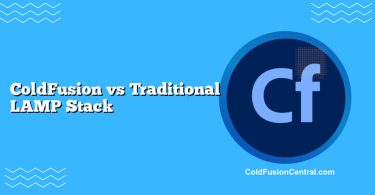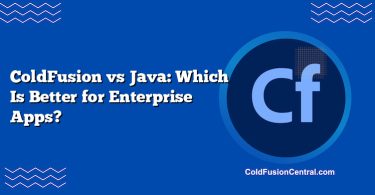Definitions
-
ColdFusion: A high-level, rapid application development platform originally by Allaire, now Adobe (with an open-source fork called Lucee). It runs on the JVM and uses the CFML language (tag-based and script-style) to build server-side web applications, APIs, and scheduled jobs on traditional servers or VMs.
-
Cloudflare Workers: A serverless, edge-compute runtime that executes JavaScript/TypeScript (and WebAssembly) in Cloudflare’s global network using V8 isolates. It’s designed for ultra-low-latency APIs, middleware, and request handling close to users, with managed scaling and integrated edge data services (KV, D1, R2, Durable Objects).
Overview
ColdFusion and Cloudflare Workers solve different problems along the web stack. ColdFusion is an application server and full-stack framework geared toward building and hosting stateful, business-heavy applications—often within a corporate data center or cloud VM. Cloudflare Workers is a serverless, event-driven platform at the edge, ideal for globally distributed APIs, routing, rewrites, and latency-sensitive workloads with ephemeral compute.
If your team maintains an enterprise application tied to relational databases, scheduled tasks, and server-based integrations, ColdFusion provides a batteries-included environment. If you want near-instant response times worldwide with auto-scaling and minimal ops, Cloudflare Workers offers a modern edge computing model.
Key Features
ColdFusion (Adobe CF / Lucee)
- CFML language with both tag-based and script syntax
- Built-in services: caching, mail, PDF, image manipulation, ORM/Hibernate integration, scheduled tasks
- Mature JDBC integration and datasource management
- Robust admin console and configurable application lifecycle
- Runs on Windows/Linux/macOS servers or containers
- Optional clustering for session replication and load balancing
- Commercial support (Adobe) and open-source alternative (Lucee)
Cloudflare Workers
- JavaScript/TypeScript runtime on V8 isolates; also supports WebAssembly
- Global deployment to 300+ PoPs with single-command publishing
- Integrated data/services: KV (key-value), D1 (SQLite-based relational DB), R2 (object storage), Durable Objects (stateful coordination), Queues, Cron Triggers
- Zero-maintenance scaling; cold starts are usually negligible due to isolates
- Seamless integration with Cloudflare CDN, Pages, WAF, and Zero Trust
- Fine-grained routing via workers.dev or your custom domains
Performance
-
ColdFusion
- Runs on the JVM with JIT optimizations; excellent throughput on well-provisioned servers.
- Performance depends on server sizing, JVM tuning, and database design.
- Network latency equals distance to your servers; global users may see higher latency unless you place servers regionally or use a CDN for static assets.
- Warm state and persistent connections make it great for complex workflows and heavy database usage.
-
Cloudflare Workers
- Executes at the edge for extremely low latency to users worldwide.
- Isolates keep cold starts minimal; scale happens automatically with traffic.
- CPU time is constrained per request. Use Workers Unbound for longer compute, or offload heavy tasks to Queues/Batch or backend services.
- Ideal for lightweight compute, routing, and caching; can front heavier origins.
Scalability
-
ColdFusion
- Scales vertically (more CPU/RAM) or horizontally with clustering.
- Requires session/state strategy: sticky sessions, shared session store, or stateless tokens.
- Ops overhead includes OS, JVM, CF updates, and scaling the database.
-
Cloudflare Workers
- Automatic, elastic scaling across the network. No servers to manage.
- Data consistency patterns matter: KV is eventually consistent; Durable Objects provide single-writer consistency; D1 offers relational semantics with regional considerations.
- Pair with regional databases or distributed stores for write-heavy workloads.
Security
-
ColdFusion
- Security considerations include patch management, CF Administrator hardening, WAF, and secure coding against CFML-specific and general web vulnerabilities.
- Enterprise features (Adobe CF Enterprise) include lockdown guides, sandboxing, and secure profile options.
- Compliance depends on your hosting environment and controls.
-
Cloudflare Workers
- Isolation by design (per-request, per-tenant) reduces blast radius.
- TLS, WAF, bot management, and Zero Trust integrations at the edge.
- Secrets are managed via environment bindings. Platform is auto-patched and monitored by Cloudflare.
Cost
-
ColdFusion
- Adobe ColdFusion licenses are commercial and typically priced per-core; costs can be significant for large deployments. Support is available.
- Lucee is open-source (no license cost), but you still pay for infrastructure, support, and operations.
- Consider costs for HA/DR, monitoring, and maintenance.
-
Cloudflare Workers
- Usage-based pricing; generous free tier for development and small workloads.
- Paid plans scale with requests, CPU time, and storage usage (KV, D1, R2, Durable Objects).
- Low ops overhead; you don’t manage servers.
- Exact pricing changes over time; always verify current rates on Cloudflare’s site.
Developer Experience and Language
-
ColdFusion
- CFML offers rapid development with tag-based (e.g.,
, ) and script-based syntax (cfscript). - Tight integration with relational databases, form processing, PDF generation, and scheduled tasks.
- Great for teams that value fast prototyping, readable server-side templates, and direct JDBC access.
- CFML offers rapid development with tag-based (e.g.,
-
Cloudflare Workers
- JavaScript/TypeScript first; modern tooling like Wrangler CLI and Modules syntax.
- Event-driven programming model: fetch(request) handlers, scheduled events, durable state constructs.
- Lean, composable approach. Ideal if your team is fluent in JS/TS and wants to adopt a micro-frontend/microservice pattern.
Language/Syntax Snapshot
-
CFML example (pseudo):
- Query:
SELECT * FROM users - Return JSON:
#serializeJSON(q)#
- Query:
-
Workers example (simplified):
- Export a fetch handler in JS/TS
- Use D1.prepare(‘SELECT * FROM users’) and return new Response(JSON.stringify(rows))
Ecosystem and Community Support
-
ColdFusion
- Adobe ecosystem with long enterprise history; official support and updates.
- Lucee community offers active forums and extensions.
- Many legacy codebases and seasoned CF developers in enterprises.
-
Cloudflare Workers
- Rapidly growing community centered on serverless and edge computing.
- Rich ecosystem: KV, R2, D1, Durable Objects, Queues, Pages, AI integrations.
- Extensive docs, templates, and examples; large user base across startups and large-scale platforms.
Real-World Use Cases
When ColdFusion is preferred
- Internal enterprise systems with complex business logic, workflows, and report generation.
- Applications requiring tight relational database integration, stored procedures, and ORM.
- Teams with existing CFML expertise and on-prem compliance needs.
Scenario:
- An insurance company runs a policy management portal with CFML components, scheduled data feeds, secure intranet access, and heavy Oracle integration. ColdFusion’s built-in scheduling, mail, PDF, and data access reduces glue code. The app runs behind the corporate firewall with SSO and a WAF.
When Cloudflare Workers is preferred
- Global APIs and microservices that must respond quickly to users everywhere.
- Edge caching, routing, and A/B testing without touching origin servers.
- Modern JAMstack sites with Workers doing rewrites, authentication, and data enrichment at the edge.
Scenario:
- A SaaS provides public APIs to customers across regions. Using Workers, it terminates TLS, validates tokens, checks feature flags from KV, fetches user-specific data from D1/Durable Objects, and returns responses with sub-50ms latency globally—no server fleet to manage.
Side-by-Side Comparison Table
| Aspect | ColdFusion (Adobe/Lucee) | Cloudflare Workers |
|---|---|---|
| Model | Application server on JVM | Serverless edge runtime (V8 isolates) |
| Language | CFML (tags + script), integrates with Java | JavaScript/TypeScript, WebAssembly |
| Performance | Strong throughput on sized servers; latency tied to region | Ultra-low latency globally; small cold starts; CPU-constrained per request |
| Scalability | Manual scaling/clustering | Automatic global scaling |
| State/Data | In-memory sessions, DB, caches | KV (eventual), Durable Objects (consistent), D1 (relational), R2 (objects) |
| Security | Patch OS/JVM/CF; WAF recommended | Edge WAF, Zero Trust, secrets, managed patches |
| Cost | License (Adobe) or free (Lucee) + infra/ops | Usage-based, low ops overhead |
| Use Cases | Enterprise apps, heavy DB/reporting | Edge APIs, routing, middleware, CDN logic |
| Pros | Rapid dev, batteries-included features | Global latency, effortless scaling, ecosystem |
| Cons | Ops burden, regional latency, license cost (Adobe) | CPU limits, new consistency patterns, vendor lock-in risk |
Pros and Cons
ColdFusion
Pros:
- Rapid development with CFML and built-in services (mail, PDF, image, ORM).
- Strong RDBMS integration and mature JDBC support.
- Stable enterprise footprint; Adobe support or Lucee flexibility.
- Runs anywhere you can host a JVM.
Cons:
- Operational overhead: servers, patches, clustering.
- License costs for Adobe ColdFusion; DBA/ops complexity for HA.
- Regional latency unless you deploy multiple regions or add edge layers.
- Smaller modern hiring pool compared to JS/TS.
Cloudflare Workers
Pros:
- Global low latency by default; auto-scaling without servers.
- Integrated edge services: KV, D1, R2, Durable Objects, Queues.
- Developer-friendly if you already use JS/TS.
- Security and patching are largely managed by the platform.
Cons:
- Compute limits; heavy processing may need Unbound or offloading.
- New data consistency models to learn (e.g., KV eventual consistency).
- Vendor lock-in to Cloudflare’s platform/APIs.
- Debugging distributed edge behavior can be nuanced.
Decision Factors / Which One Should You Choose?
-
Choose ColdFusion if:
- Your app is a stateful, business-heavy system with complex server-side workflows.
- You need tight relational DB workflows, scheduled jobs, and PDF/report generation out of the box.
- Your team already has CFML expertise or you are modernizing an existing CF codebase.
- Compliance or architecture prefers on-prem or VM-based deployment patterns.
-
Choose Cloudflare Workers if:
- You require global low-latency APIs or middleware with minimal ops.
- You favor serverless and edge computing, with modern JS/TS stacks.
- Workloads are I/O-bound and benefit from caching, request transformation, and distributed presence.
- You want to combine with KV/D1/R2/Durable Objects to build scalable microservices without managing servers.
Pragmatic hybrid:
- Keep core business systems in ColdFusion (or any server-based framework), and front them with Workers for edge caching, auth, rate-limiting, and request shaping. This reduces origin load and improves global user experience.
Step-by-step selection approach:
- Map latency needs: global SLA or regional users?
- Classify workloads: compute-heavy batch vs. request-time logic.
- Identify data patterns: strong consistency vs. eventually consistent cache.
- Calculate total cost: licenses + ops vs. usage-based edge.
- Assess team skills: CFML/Java vs. JS/TS.
- Consider migration path or hybrid fronting with Workers.
Key Takeaways
- ColdFusion is a feature-rich application server best for stateful, DB-centric enterprise apps with rapid development needs and clear hosting control.
- Cloudflare Workers is a serverless edge platform tuned for low-latency, globally distributed APIs, routing, and request processing with minimal operations.
- Performance differs by design: JVM throughput vs. edge latency. Choose based on your data and consistency needs, not just raw speed.
- Cost profiles vary: license + infra (ColdFusion) vs. usage-based (Workers). Evaluate TCO over time.
- A hybrid strategy—edge logic on Workers, core systems on ColdFusion—often delivers the best of both worlds.
FAQ
Can I run ColdFusion and Cloudflare Workers together?
Yes. A common pattern is to keep ColdFusion as your origin application server while placing Cloudflare Workers in front for authentication, caching, URL rewrites, and A/B testing. Workers can call your ColdFusion APIs and reduce latency for end users.
Is Lucee a drop-in replacement for Adobe ColdFusion?
Lucee implements most CFML features and is compatible with many codebases, but not every Adobe-specific tag or enterprise feature is identical. Test critical features, admin settings, and libraries before switching.
How do I handle database writes on Cloudflare Workers?
Use Durable Objects for coordination or Cloudflare D1 for relational data near the edge. For global consistency, design around region placement, consider a single-writer pattern, or integrate with a strongly consistent backend database via APIs.
Are there CPU limits on Cloudflare Workers?
Yes. Standard Workers limit CPU time per request, optimized for quick edge tasks. Workers Unbound offers higher CPU allowances for heavier workloads. Offload long-running tasks to Queues, batch processors, or backend services.
What about vendor lock‑in with Workers?
Workers’ APIs (KV, Durable Objects, D1) are specific to Cloudflare. You can mitigate lock-in by abstracting storage access, using open formats, or placing business logic in portable modules, but complete portability requires careful architecture.




